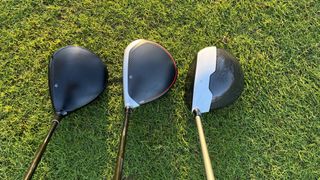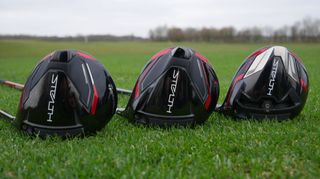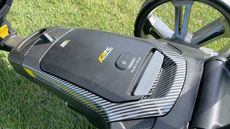How Often Should You Upgrade Your Driver?
In this video, Neil Tappin and Joel Tadman ask how often should you upgrade your driver?


How Often Should You Upgrade Your Driver?
This is a question many golfers consider, especially as equipment manufacturers produce new models that promise even more distance and forgiveness than the previous generation. It leaves many of us asking should I buy a new driver in 2022?
How much of a difference do the technical developments make to the overall performance and if you choose not to invest in a new driver for a few years, what exactly are you giving up on? These are the questions that Neil and Joel look to answer in the video below.
WATCH - How Often Should You Upgrade Your Driver?
Here we tested a host of drivers from different eras to gauge the difference in looks, feel/sound, performance, adjustability and also the price so if you have an older driver and you have been thinking about upgrading, this will help you decide on whether a change will deliver better results.
Looks
This is a subjective category of course but one thing to note is sometimes the more eye-catching designs that were popular at the time can look a little dated sooner. Take the TaylorMade M1 pictured below. This was released in 2015 and the two-tone crown looked modern and fresh back then. Now, as TaylorMade has refined its clubheads over time, so we think the original M1 is starting to look a little dated.

However, brands like Titleist may not have quite the same issue as it tends to keep the aesthetics consistent over time. The Titleist TSi3 driver is one of the best golf drivers on the market this year and it has a trademark look. The earliest driver we hit on this test was the 905 and whilst Titleist has tweaked the design, the differences are modest.
One important thing to note is that early drivers are not likely to be 460cc which means newer drivers do have a more generous hitting area - the Ping G425 Max driver is a good example of one with a large, confidence-inspiring footprint. This means if you are using an older and smaller driver, chances are you will be losing out on performance.
Get the Golf Monthly Newsletter
Subscribe to the Golf Monthly newsletter to stay up to date with all the latest tour news, equipment news, reviews, head-to-heads and buyer’s guides from our team of experienced experts.
Sound/Feel
This category is where you possibly feel the biggest difference in drivers. Many brands use materials which produce a higher-pitched sound, whereas others try to create a duller, more muted sound. Once again this is all about personal preference.
This year TaylorMade has introduced carbon into the face of its driver. The TaylorMade Stealth driver, along with the HD and Plus models, still feels quite muted and powerful through impact. Another thing to note is the sound the driver makes when not struck in the middle. Older drivers seem to make a distinctly different sound when struck nearer the heel or toe whereas newer drivers mask that somewhat.

Performance
Are there tangible performance gains to be had when comparing new to old drivers Well in testing Joel found that when struck out of the middle, the performance on offer in the older models was comparable to his usual performance with newer models. However on the mis-hits, there were clear drop-offs.
In testing Neil found the same conclusions too. The key here is the consistency of distance because with newer models of driver, the mis-hits go further because of the forgiveness on offer. The spin rates too are more consistent. Another thing to note is modern drivers have adjustability which can help with dispersion if setup correctly whereas older drivers are more limited.
Price
Every golfer will have their own budget but what cannot be ignored is that modern, premium drivers come with premium prices. As a result good bargains can be had on used drivers however you should acknowledge that these drivers will not have the fitting options comparable to newer models, and they will age faster too.
We also recommend thinking about how often you want to upgrade your driver because if it is every few years, then a less expensive pre-owned option could be the way to go. Alternatively if you upgrade only every five or six years, then perhaps spending a little bit more could be more beneficial to you.

Verdict
The big question we were trying to answer is how often should you upgrade your driver. Now there may not be a definitive answer here but one of the main conclusions we came to was that from generation to generation, we are talking marginal gains. So if your driver is only a couple of years old, a new one may not revolutionize your performance.
However any older than that and there are clear benefits to be had in terms of total performance, forgiveness, adjustability and so on. If you can couple that with a custom fitting then we are confident that upgrading will deliver results.

In July 2023, Neil became just the 9th editor in Golf Monthly's 112-year history. Originally working with the best coaches in the UK to produce instruction content, he has also presented many Golf Monthly videos looking at all areas of the game from Tour player interviews to the rules of golf.
Throughout his time with the brand he has also covered equipment launches that date back well over a decade. He clearly remembers the launch of the Callaway and Nike square drivers as well as the white TaylorMade driver families, such as the RocketBallz! If you take a look at the Golf Monthly YouTube channel, you'll see his equipment videos dating back over a decade! He has also conducted 'What's In The Bag' interviews with many of the game's best players like Rory McIlroy, Dustin Johnson and Jon Rahm. Over the years, Neil has tested a vast array of products in each category and at drastically different price-points.
Neil is currently playing: Driver: TaylorMade Stealth Plus Fairway Wood: Titleist TSR2 Hybrid: Titleist TS3 Irons: PING Blueprint S (4&5), PING Blueprint T (6-PW) Wedges: Titleist Vokey SM7 50˚, 54˚, 60˚ Putter: Odyssey Triple Track Ten Ball: Titleist Pro V1X
- Joel TadmanTechnical Editor
- Sam TremlettE-commerce Editor
-
 'We're Not Going To Change Anything' - Rahm And Hatton Remain Eligible For Ryder Cup Selection Says New DP World Tour Boss
'We're Not Going To Change Anything' - Rahm And Hatton Remain Eligible For Ryder Cup Selection Says New DP World Tour BossNew DP World Tour boss Guy Kinnings says Jon Rahm and Tyrrell Hatton will remain eligible for Ryder Cup selection as long as they follow the current criteria already in place
By Paul Higham Published
-
 Watch: Cameron Smith Followed Down 18 By Massive Crowd In Throwback Scenes At LIV Golf Adelaide
Watch: Cameron Smith Followed Down 18 By Massive Crowd In Throwback Scenes At LIV Golf AdelaideIf anyone doubted The Australian's cult status Down Under, these pictures from LIV Golf Adelaide should clear it up...
By Jonny Leighfield Published
-
 7 Ways To Play Better Without Spending Money
7 Ways To Play Better Without Spending MoneyGetting better at golf doesn't have to be as expensive as you might think...
By Andrew Wright Published
-
 How To Pay Less For Your Next Set Of Irons
How To Pay Less For Your Next Set Of IronsIrons are an expensive investment, but there's plenty of ways to pay less for your next set...
By Dan Parker Last updated
-
 How To Make Your Golf Shoes Last Longer
How To Make Your Golf Shoes Last LongerHere are some top tips on how to get the most out of your latest pair of golf shoes
By Dan Parker Published
-
 “I've Always Played A Premium Ball But Now I've Decided To Switch... Here's Why"
“I've Always Played A Premium Ball But Now I've Decided To Switch... Here's Why"Longstanding contributor, Jeremy Ellwood, explains why he's moved away from playing the premium balls he'd always relied on
By Jeremy Ellwood Published
-
 15 Easy Ways To Make Golf More Affordable
15 Easy Ways To Make Golf More AffordableGolf is an expensive endeavor but there are ways you can save money when it comes to every aspect of your game that will add up in a big way over time
By Chris Wallace Last updated
-
 20 Best Cheap Golf Products
20 Best Cheap Golf ProductsOur picks for quality golf products that will help you play better golf and save money in the process
By Chris Wallace Last updated
-
 Where To Spend And Save Money On Golf Gear
Where To Spend And Save Money On Golf GearJoel Tadman and Dan Parker give their thoughts on where to spend and where to save money on new golf gear
By Joel Tadman Last updated
-
 How To Make Golf Cart Batteries Last Longer
How To Make Golf Cart Batteries Last LongerWe take a look at some practical advice from manufacturers on how to make golf cart batteries last longer
By Dan Parker Published